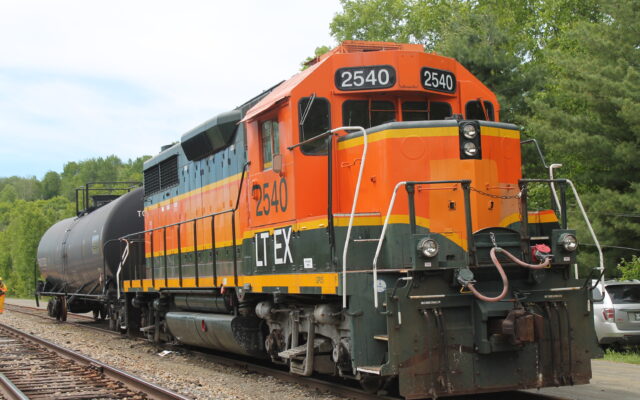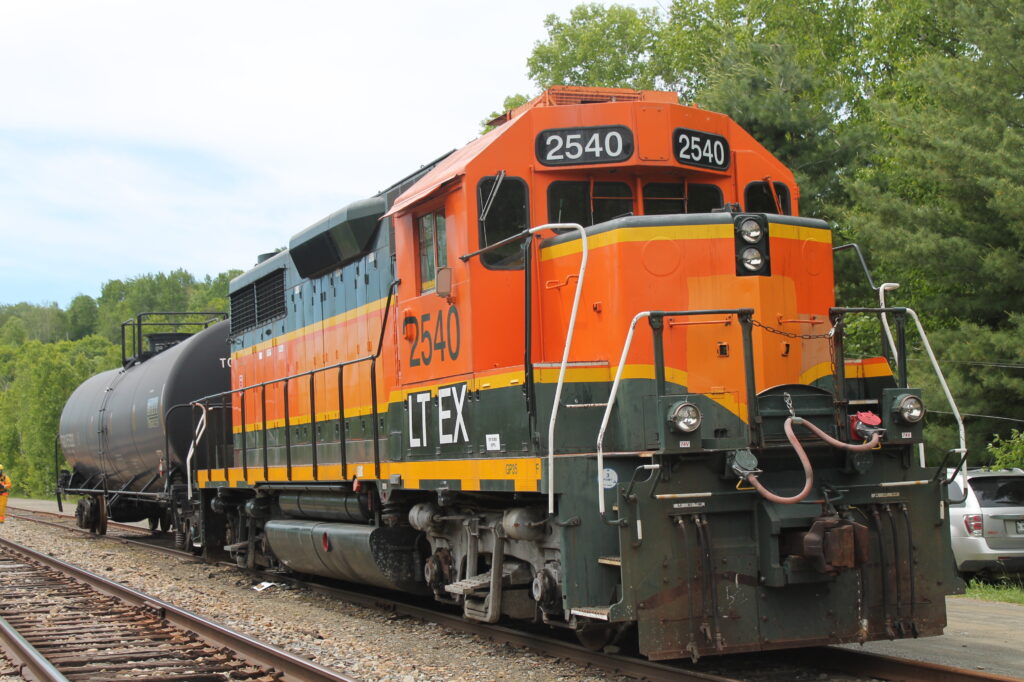
Jump in freight traffic brings hope and headaches to rural Maine towns along rail route
By Bill Trotter, Bangor Daily News Staff
As more freight trains travel across Maine between northern Washington County and northern Somerset County, rural towns along the route have had to balance their hopes for improving their local economies with logistical challenges presented by the increased rail traffic.
Vanceboro, where Canadian trains from the growing Port of Saint John cross into Maine en route to Quebec, may face the biggest logistical complication of them all.
U.S. Customs and Border Patrol has said it will start closing the vehicle crossing there for 12 hours a day, instead of keeping it open around the clock, so it can “better serve rail traffic” that crosses the Saint Croix River from Canada.

TANK CAR – A Central Maine and Quebec Railway locomotive and tank car that were used in a training exercise in Greenville Junction are shown in this 2015 file photo.
“The port of Vanceboro has seen a substantial increase in rail traffic while demonstrating a decrease in vehicle traffic,” an agency spokesperson said recently. “Those officers currently dedicated to processing passengers during the reduction period will be reallocated to inspecting cargo and rail traffic.”
That doesn’t sit well with local officials in Vanceboro and McAdam, five miles across the border in New Brunswick, who say that the reduced access would greatly disrupt life for area residents, many of whom have dual citizenship and relatives on opposite sides of the border. About 100 people live in Vanceboro and 1,000 live in McAdam.
Cheryl Long, a Vanceboro selectman and former local railroad employee, said that despite the agency’s claims about declining vehicle traffic, she has noticed that more people have moved to the town in the past two years. She said the jump in train traffic across the border should be a reason for expanding border patrol resources in Vanceboro, not reducing vehicle access.
“I don’t think there is even one house for sale in town,” Long said. “I hope the train traffic will keep growing. There should be a lot more jobs available.”
Cheryl Nadeau, Jackman’s town manager, said that after Canadian Pacific bought the former Central Maine and Quebec Railway line in 2020, it sent crews to town for a few months to upgrade the line. Most of the local lodging businesses were full and the restaurants were busy while the work was being done, which helped the local economy, she said.
The company also has added two new jobs that are based in Jackman.
But the trains are long, and each time they cross Main Street in Jackman — three or four times a day — they bring local traffic to a halt for 30 minutes or more. They also are required to blast their horns at the crossing, which wakes up nearby residents at night.
The repeated train crossings at Main Street are not just a matter of inconvenience, Nadeau said. What worries local officials most is that the town’s ambulance service and fire station are located on one side of the tracks, and the local health center is on the other. Having them cut off from each other while a train is passing through town could hamper response times in an emergency, she said.
“That is our biggest issue,” Nadeau said. “The trains have been two miles long, and sometimes they are longer than that. We’re going to talk to Maine DOT about some of our concerns.”
In Brownville, which long has hosted an operations junction for the railroads that have owned the line, the increase in rail traffic has not posed any significant complications for local residents. The impact of Canadian Pacific coming to town has been positive, said Felice Lyford, Brownville’s town manager.
“They have put in money,” Lyford said, adding that the company built a new operations building in town last year. “There are a great deal of residents in this area who work for the railroad.”
The number of people employed by rail companies has fluctuated over the years, but trains have always been a major part of the town’s identity, she said. For decades, many local residents who didn’t work for the railroad commuted jobs at the paper mill in Millinocket or the shoe factory in Dexter. Those businesses shut down in the early 2000s, around the same time that Bangor and Aroostook Railroad, the local rail operator at the time, went bankrupt.
“It was pretty devastating to this area,” Lyford said. “Activity dwindled down so much. To have the railroad pick up and come back is a big deal.”